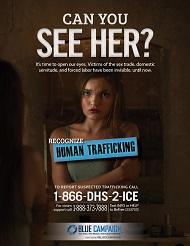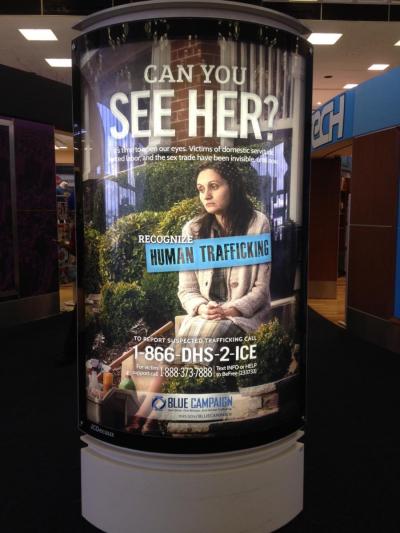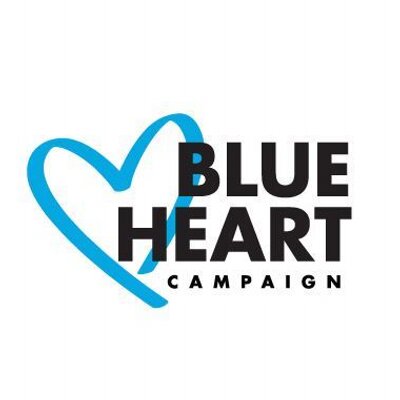Invisible, Until Now: The Blue Campaign
Have you ever been strolling through the airport, triple checking flights, and about to grab some peppermint gum for takeoff when you notice one of those “Recognize Human Trafficking” posters? Bold letters ask, “Can you see him?” “Can you see her?” Below, another sentence states, “It’s time to open our eyes. Victims of the sex trade, domestic servitude, and forced labor have been invisible, until now.”
Ads like these counter the myth that human trafficking happens somewhere “out there” or that it’s an overseas issue. Human trafficking often goes unseen in our own backyards: truck stops, neighborhoods, and airports. Whether in forced labor, the sex trade, or domestic servitude, human trafficking victims seldom step forward for help due to language barriers, fear of their traffickers, and/or fear of law enforcement. Because of this, human trafficking is often an invisible crime. The folks that created the Blue Campaign believe that this can change.
These powerful ads originate from the Blue Campaign, which began in 2010 by the U.S. Department of Homeland Security (DHS) as a unified effort to combat human trafficking. The Blue Campaign teams up with law enforcement, government, non-governmental and private organizations, and “strives to protect the basic right of freedom and to bring those who exploit human lives to justice.”
So why blue? The Blue Campaign logo and name uses the color blue as the international symbol for human trafficking awareness, in addition to referring to other anti-trafficking campaigns, including the Blue Heart and the Blue Blindfold, as well as the "thin blue line" of law enforcement. Posters displaying this logo are intentionally placed “at port of entry and airport departure gates and include information about how to report suspected human trafficking to authorities.”
Along with posters, the Blue Campaign offers many free resources to educate and train others to recognize and report human trafficking. Even a little training can go a long way. For instance, a flight attendant, named Nancy Rivard, attended a workshop on how to spot human trafficking and held on to a hotline number to call in case she witnessed any suspicious activities. While flying home one day, she noticed suspicious behavior and reported the incident to the hotline. Weeks later, she received a call from DHS that her tip uncovered a child trafficking ring in Boston of 82 children brought illegally from the Dominican Republic to the United States. All 82 children were rescued. It’s incredible what one person can do.
You never know how your actions might lead others to freedom. As a quote from one of my favorite movies (Lord of the Rings, what’s up?!) states, “Even the smallest person can change the course of the future.”
So, what can you do? With amazing resources from the Blue Campaign, there are many ways you can join the fight to end modern day slavery:
Distribute Posters & Other Resource Materials:
Download and print Blue Campaign posters and materials to help educate your community to watch for signs of trafficking and report suspicious activity. Seek permission from local businesses to hang materials on the inside or outside of their establishment.
Educate Yourself through Awareness Training:
Take the Human Trafficking Awareness Training online and watch, download, and share free videos on general awareness, and on recognizing the signs of trafficking that occurs right under our noses: including places like rest stops and foster care homes. Encourage your friends, family, coworkers, employees, partners, and community to take the training and watch videos as well.
Utilize Social Media:
Follow the Blue Campaign on Facebook or Twitter, share content, and tag the campaign in your posts about human trafficking awareness and education efforts. Use the hashtags #BlueCampaign and #endtrafficking.
Host Events:
Host an educational session or campus event. Events are powerful ways to educate, promote conversations, and empower individuals to recognize human trafficking signs and to take action.
Report Human Trafficking Tips:
Do not at any time attempt to confront a suspected trafficker directly, or alert a victim to your suspicions.
To report suspicious human trafficking activity, call: 1 (888) 373-7888, submit a tip online at https://humantraffickinghotline.org/report-trafficking or text HELP or INFO to BeFree (233733).
Individuals across the world can also report suspicious criminal activity to the HSI Tip Line 24/7 by calling: 1-802-872-6199.
Although there’s still a long way to go in the fight to end modern day slavery, the Blue Campaign provides much needed awareness, training, partnership, and support towards combating human trafficking. As one of the Blue Campaign’s posters states, “Some prisons have metal bars, and some have picket fences." Hopefully these posters remind us modern day slavery isn’t just an overseas or ancient issue but also a current, white picket fence issue, invisible in its ordinariness. Until now. Let’s bring this crime out of the shadows.
About the Author
Lauren Farris is a recent graduate from the University of Washington with a degree in Creative Writing and Sociology, and she's excited to partner with Dressember in the fight to end slavery. She also adores corgis, messy paint, mud, hiking in wildflowers, reading, traveling, and a good Lord of the Rings marathon.








